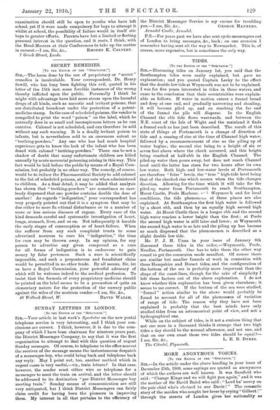TIDES.
[To THE EDITOR OF THE " SPECTATOR."] SIR,—Discussing tides on January 1st, you said that the Southampton tides were easily explained, but gave no explanation; and you quoted Captain Lecky to the effect that the double low tide at Weymouth was not to be explained. I was for five years interested in tides in these waters, and came to the conclusion that their eccentricities were explain- able as follows. If water in motion enters a funnel broad and deep at one end, and gradually narrowing and shoaling, it will become piled up, and on reaching the far end of the funnel the pile will disperse. In the English Channel the ebb tide flows westwards, and between the N.E. coast of the Isle of Wight and the mainland it finds a funnel such as has just been described. The result of this state of things at Portsmouth is a change of direction of tide and a ceasing of rise at the time of Channel high water, followed by a recommencement of rise as the piling up of water begins; the second rise being to a height of six or seven feet above where the check occurred, and this height being reached at half-ebb in the English Channel. The piled-up water then pours away, but does not reach Channel level until the latter has risen for two hours after its own low water. Both high- and low-water levels at Portsmouth are therefore " false " levels, the " true " high-tide level being that of the checked rise which occurs when the tide changes direction. Allowing for the time which it will take for the piled-up water from Portsmouth to reach Southampton, Hurst Castle, Poole Harbour, - 1 Weymouth and for local conditions, the tide phenomeua at these places are also explained. At Southampton the first high water is followed by a short ebb, and then by an equally high second high water. At Hurst Castle there is a longer ebb and the second high water reaches a lower height than the first ; at Poole the second high water is still later and lower ; at Weymouth the second high water is so late and the piling up has become so much dispersed that the phenomenon is described as a slight double low tide.
Mr. P. J. H. Unna in your issue of January 8th discussed these tides in the order, —Weymouth, Poole, Needles, Portsmouth. One has to take them the other way round to get the connexion made manifest. Of course there are similar but smaller funnels at work in connexion with these Hampshire and Dorset tides, and the configuration of the bottom of the sea is probably more important than the shape of the coast-lines, though for the sake of simplicity I left these factors out of the above explanation. I do not know whether this explanation has been given elsewhere ; it seems to me correct. If the bottom of the sea were studied, " funnel " action similar to the above would probably be found to account for all of the phenomena of variation of range of tide. The reason why they have not been explained is probably that the best minds have only studied tides from an astronomical point of view, and not a bydrographical one. While on the subject of tides, is it not a curious thing that not one man in a thousand thinks it strange that two high tides a day should be the normal allowance, and not one, and that on our own coast these two tides should be equal ?-






































 Previous page
Previous page